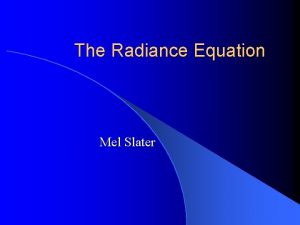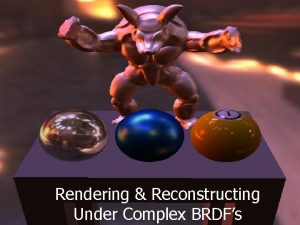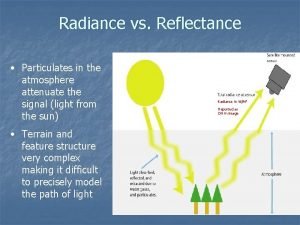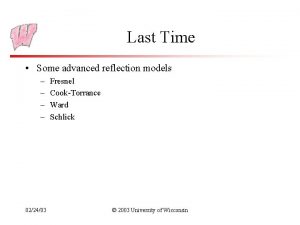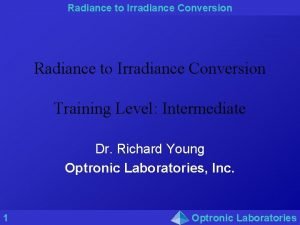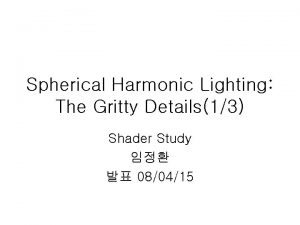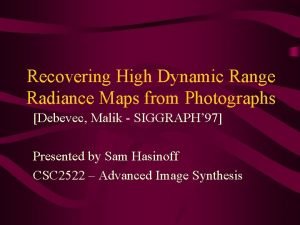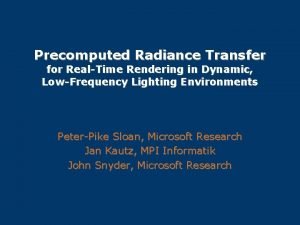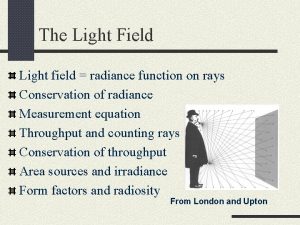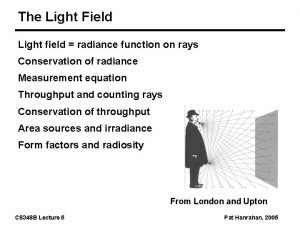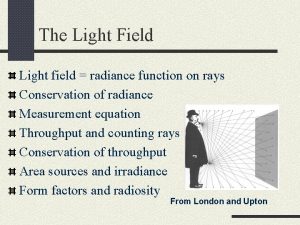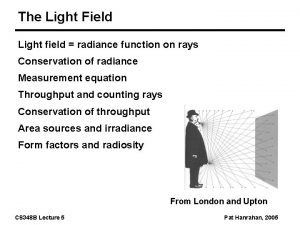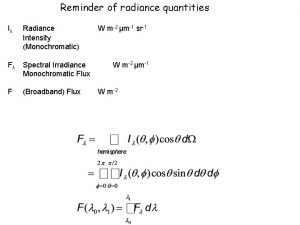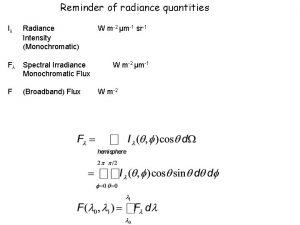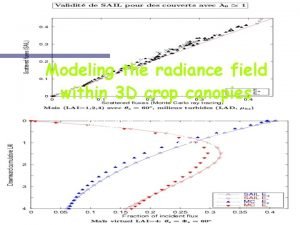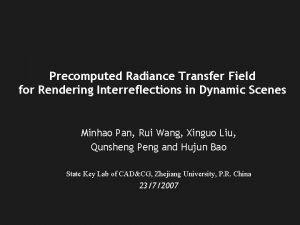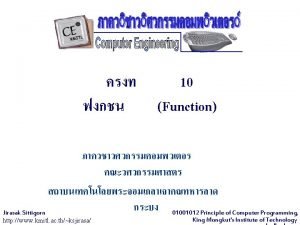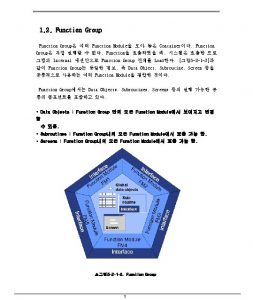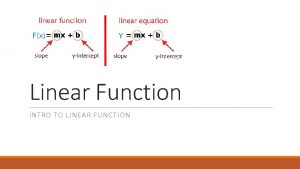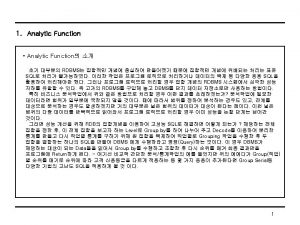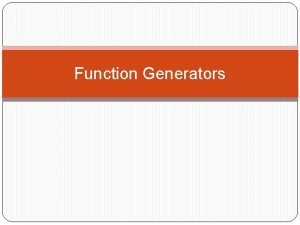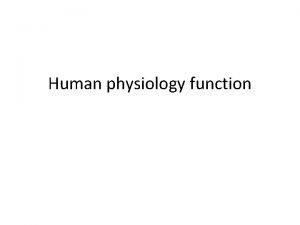The Light Field Light field radiance function on











































- Slides: 43

The Light Field Light field = radiance function on rays Conservation of radiance Measurement equation Throughput and counting rays Conservation of throughput Area sources and irradiance Form factors and radiosity From London and Upton CS 348 B Lecture 5 Pat Hanrahan, 2005

Light Field = Radiance(Ray)

Field Radiance Definition: The field radiance (luminance) at a point in space in a given direction is the power per unit solid angle per unit area perpendicular to the direction Radiance is the quantity associated with a ray CS 348 B Lecture 5 Pat Hanrahan, 2005

Properties of Radiance

Properties of Radiance 1. Fundamental field quantity that characterizes the distribution of light in an environment. 1. Radiance is a function on rays 2. All other field quantities are derived from it 2. Radiance invariant along a ray. 1. 5 D ray space reduces to 4 D 3. Response of a sensor proportional to radiance. CS 348 B Lecture 5 Pat Hanrahan, 2005

1 st Law: Conversation of Radiance The radiance in the direction of a light ray remains constant as the ray propagates CS 348 B Lecture 5 Pat Hanrahan, 2005

1 st Law: Conversation of Radiance The radiance in the direction of a light ray remains constant as the ray propagates CS 348 B Lecture 5 Pat Hanrahan, 2005

Spherical Gantry 4 D Light Field Capture all the light leaving an object - like a hologram CS 348 B Lecture 5 Pat Hanrahan, 2005

Two-Plane Light Field 2 D Array of Cameras CS 348 B Lecture 5 2 D Array of Images Pat Hanrahan, 2005

Multi-Camera Array Light Field CS 348 B Lecture 5 Pat Hanrahan, 2005

Throughput Counts Rays Define an infinitesimal beam as the set of rays intersecting two infinitesimal surface elements T measures/count the number of rays in the beam CS 348 B Lecture 5 Pat Hanrahan, 2005

Conservation of Throughput n Throughput conserved during propagation n Number of rays conserved n Assuming no attenuation or scattering n n 2 (index of refraction) times throughput invariant under the laws of geometric optics n Reflection at an interface n Refraction at an interface n n Causes rays to bend (kink) Continuously varying index of refraction n Causes rays to curve; mirages CS 348 B Lecture 5 Pat Hanrahan, 2005

Conservation of Radiance is the ratio of two quantities: 1. Power 2. Throughput Since power and throughput are conserved, Radiance conserved CS 348 B Lecture 5 Pat Hanrahan, 2005

Quiz Does radiance increase under a magnifying glass? CS 348 B Lecture 5 Pat Hanrahan, 2005

Quiz Does radiance increase under a magnifying glass? No!! CS 348 B Lecture 5 Pat Hanrahan, 2005

Radiance: 2 nd Law The response of a sensor is proportional to the radiance of the surface visible to the sensor. Aperture Sensor L is what should be computed and displayed. T quantifies the gathering power of the device; the higher the throughput the greater the amount of light gathered CS 348 B Lecture 5 Pat Hanrahan, 2005

Quiz Does the brightness that a wall appears to the sensor depend on the distance? CS 348 B Lecture 5 Pat Hanrahan, 2005

Measuring Rays = Throughput

Throughput Counts Rays Define an infinitesimal beam as the set of rays intersecting two infinitesimal surface elements Measure/count the number of rays in the beam CS 348 B Lecture 5 Pat Hanrahan, 2005

Parameterizing Rays Parameterize rays wrt to receiver CS 348 B Lecture 5 Pat Hanrahan, 2005

Parameterizing Rays Parameterize rays wrt to source CS 348 B Lecture 5 Pat Hanrahan, 2005

Parameterizing Rays Tilting the surfaces reparameterizes the rays All these throughputs must be equal. CS 348 B Lecture 5 Pat Hanrahan, 2005

Projected Solid Angle CS 348 B Lecture 5 Pat Hanrahan, 2005

Parameterizing Rays: S 2 × R 2 Parameterize rays by Projected area Measuring the number or rays that hit a shape Sphere: CS 348 B Lecture 5 Pat Hanrahan, 2005

Parameterizing Rays: M 2 × S 2 Parameterize rays by Sphere: Crofton’s Theorem: CS 348 B Lecture 5 Pat Hanrahan, 2005

Incident Surface Radiance Definition: The incoming surface radiance (luminance) is the power per unit solid angle per unit projected area arriving at a receiving surface CS 348 B Lecture 5 Pat Hanrahan, 2005

Exitant Surface Radiance Definition: The outgoing surface radiance (luminance) is the power per unit solid angle per unit projected area leaving at surface Alternatively: the intensity per unit projected area leaving a surface CS 348 B Lecture 5 Pat Hanrahan, 2005

Irradiance from a Uniform Area Source

Irradiance from the Environment CS 348 B Lecture 5 Pat Hanrahan, 2005

Uniform Area Source CS 348 B Lecture 5 Pat Hanrahan, 2005

Uniform Disk Source Geometric Derivation CS 348 B Lecture 5 Algebraic Derivation Pat Hanrahan, 2005

Spherical Source Geometric Derivation CS 348 B Lecture 5 Algebraic Derivation Pat Hanrahan, 2005

The Sun Solar constant (normal incidence at zenith) Irradiance 1353 W/m 2 Illuminance 127, 500 lm/m 2 = 127. 5 kilolux Solar angle =. 25 degrees =. 004 radians (half angle) = 6 x 10 -5 steradians Solar radiance CS 348 B Lecture 5 Pat Hanrahan, 2005

Polygonal Source CS 348 B Lecture 5 Pat Hanrahan, 2005

Polygonal Source CS 348 B Lecture 5 Pat Hanrahan, 2005

Polygonal Source CS 348 B Lecture 5 Pat Hanrahan, 2005

Form Factors

Types of Throughput 1. Infinitesimal beam of rays (radiance) 2. Infinitesimal-finite beam (irradiance calc. ) 3. Finite-finite beam (radiosity calc. ) CS 348 B Lecture 5 Pat Hanrahan, 2005

Probability of Ray Intersection Probability of a ray hitting A’ given that it hits A CS 348 B Lecture 5 Pat Hanrahan, 2005

Another Formulation CS 348 B Lecture 5 Pat Hanrahan, 2005

Form Factor Probability of a ray hitting A’ given it hits A Form factor definition Form factor reciprocity CS 348 B Lecture 5 Pat Hanrahan, 2005

Radiosity Power transfer from a constant radiance source Set up system of equations representing power transfers between objects CS 348 B Lecture 5 Pat Hanrahan, 2005

Form Factors and Throughput Form factors represent the probability of ray leaving a surface intersecting another surface n Only a function of surface geometry Differential form factor n Irradiance calculations Form factors n Radiosity calculations (energy balance) CS 348 B Lecture 5 Pat Hanrahan, 2005
 Radiance equation
Radiance equation Total radiance
Total radiance Reflectance vs radiance
Reflectance vs radiance Total radiance
Total radiance Irradiance to radiance conversion
Irradiance to radiance conversion Precomputed radiance transfer
Precomputed radiance transfer Radiance map
Radiance map Precomputed radiance transfer
Precomputed radiance transfer Light light light chapter 23
Light light light chapter 23 Into the light chapter 22
Into the light chapter 22 Light light light chapter 22
Light light light chapter 22 Hình ảnh bộ gõ cơ thể búng tay
Hình ảnh bộ gõ cơ thể búng tay Frameset trong html5
Frameset trong html5 Bổ thể
Bổ thể Tỉ lệ cơ thể trẻ em
Tỉ lệ cơ thể trẻ em Chó sói
Chó sói Chụp tư thế worms-breton
Chụp tư thế worms-breton Chúa yêu trần thế alleluia
Chúa yêu trần thế alleluia Kể tên các môn thể thao
Kể tên các môn thể thao Thế nào là hệ số cao nhất
Thế nào là hệ số cao nhất Các châu lục và đại dương trên thế giới
Các châu lục và đại dương trên thế giới Công thức tiính động năng
Công thức tiính động năng Trời xanh đây là của chúng ta thể thơ
Trời xanh đây là của chúng ta thể thơ Mật thư anh em như thể tay chân
Mật thư anh em như thể tay chân 101012 bằng
101012 bằng Phản ứng thế ankan
Phản ứng thế ankan Các châu lục và đại dương trên thế giới
Các châu lục và đại dương trên thế giới Thơ thất ngôn tứ tuyệt đường luật
Thơ thất ngôn tứ tuyệt đường luật Quá trình desamine hóa có thể tạo ra
Quá trình desamine hóa có thể tạo ra Một số thể thơ truyền thống
Một số thể thơ truyền thống Bàn tay mà dây bẩn
Bàn tay mà dây bẩn Vẽ hình chiếu vuông góc của vật thể sau
Vẽ hình chiếu vuông góc của vật thể sau Nguyên nhân của sự mỏi cơ sinh 8
Nguyên nhân của sự mỏi cơ sinh 8 đặc điểm cơ thể của người tối cổ
đặc điểm cơ thể của người tối cổ Ví dụ giọng cùng tên
Ví dụ giọng cùng tên Vẽ hình chiếu đứng bằng cạnh của vật thể
Vẽ hình chiếu đứng bằng cạnh của vật thể Fecboak
Fecboak Thẻ vin
Thẻ vin đại từ thay thế
đại từ thay thế điện thế nghỉ
điện thế nghỉ Tư thế ngồi viết
Tư thế ngồi viết Diễn thế sinh thái là
Diễn thế sinh thái là Dạng đột biến một nhiễm là
Dạng đột biến một nhiễm là Các số nguyên tố
Các số nguyên tố
